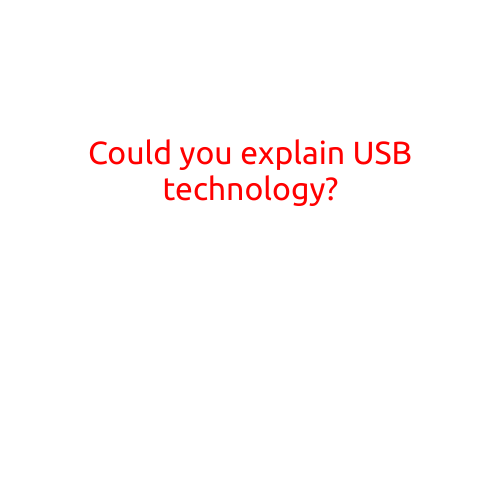
Could You Explain USB Technology?
When it comes to connecting devices to a computer or transferring data between them, USB technology has become an essential part of our daily lives. The Universal Serial Bus (USB) is a ubiquitous port that has revolutionized the way we interact with electronic devices. But have you ever wondered how it works? Let’s dive into the world of USB technology and explore its history, types, and benefits.
History of USB
The first USB specification was introduced in 1996 by a consortium of companies including Intel, Microsoft, and IBM. The initial goal was to create a standard interface that could replace a variety of proprietary ports, such as PS/2, serial, and parallel ports. The first USB devices were relatively slow, with a transfer rate of 1.5 Mbps, but quickly evolved to accommodate faster speeds.
How USB Works
USB technology uses a combination of hardware and software to establish a connection between devices. Here’s a simplified overview of the process:
- Device Discovery: When a USB device is plugged into a USB port, the computer detects it and assigns a unique address, known as a “device address.”
- Connection Establishment: The computer and device negotiate the communication parameters, including speed, power requirements, and data protocols.
- Data Transfer: The computer and device exchange data, using a standardized protocol that ensures reliable and efficient transmission.
Types of USB
Over time, USB technology has evolved to accommodate various needs, resulting in several types of USB:
- USB-A: The standard rectangular port found on most computers and devices.
- USB-B: A square-shaped port often used on devices, such as printers and scanners.
- USB-C: A reversible port that can be used for both data transfer and power delivery.
- USB 3.0: A faster version of the original USB, with transfer rates up to 5 Gbps.
- USB 3.2: The latest generation, offering speeds up to 20 Gbps.
- USB-C with Power Delivery (PD): Enables faster charging and power delivery to devices.
Benefits of USB
The widespread adoption of USB technology has led to numerous benefits, including:
- Convenience: USB devices are easy to connect and disconnect from computers and other devices.
- Flexibility: USB supports a wide range of devices, from mice and keyboards to cameras and external hard drives.
- Speed: Faster USB speeds enable rapid data transfer between devices.
- Power Delivery: USB-C with Power Delivery allows for faster charging and power delivery.
- Compatibility: USB devices are widely compatible across different operating systems and devices.
Conclusion
USB technology has come a long way since its introduction in the 1990s. With its widespread adoption and constant evolution, USB has become an essential part of our daily lives. Whether you’re a tech enthusiast, a business professional, or simply someone who loves to stay connected, USB technology is an indispensable tool that continues to shape the way we interact with electronic devices.





